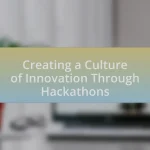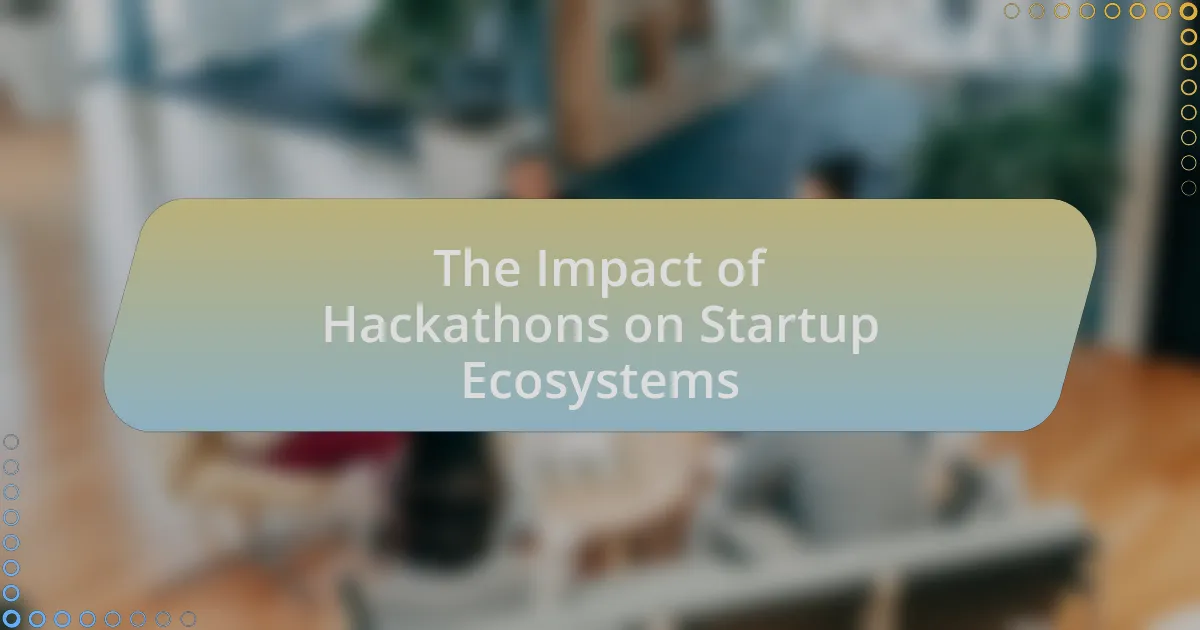The article examines the critical role of Design Thinking in hackathon planning, emphasizing its user-centered approach that enhances creativity and problem-solving. It outlines the key stages of Design Thinking—Empathize, Define, Ideate, Prototype, and Test—and discusses how these stages influence the planning process, participant engagement, and collaboration among teams. Additionally, the article highlights the importance of empathy in understanding user needs, the impact of iterative prototyping, and best practices for integrating Design Thinking into hackathons to achieve more relevant and innovative outcomes. Case studies and metrics for evaluating the effectiveness of Design Thinking in hackathons are also presented, providing a comprehensive overview of its significance in this context.

What is the Role of Design Thinking in Hackathon Planning?
Design thinking plays a crucial role in hackathon planning by fostering a user-centered approach that enhances creativity and problem-solving. This methodology encourages teams to empathize with users, define problems clearly, ideate innovative solutions, prototype rapidly, and test concepts effectively. Research indicates that organizations employing design thinking in hackathons report higher levels of participant engagement and more impactful outcomes, as it aligns the development process with real user needs and preferences. For instance, a study by the Stanford d.school highlights that design thinking can lead to more effective collaboration and a greater likelihood of successful project completion during intensive events like hackathons.
How does Design Thinking influence the hackathon planning process?
Design Thinking significantly influences the hackathon planning process by prioritizing user-centered problem-solving and iterative development. This approach encourages organizers to deeply understand participants’ needs and challenges, leading to more relevant themes and challenges that resonate with the audience. For instance, by employing empathy mapping and user journey mapping, planners can identify pain points and opportunities, ensuring that the hackathon fosters innovation that addresses real-world issues. Furthermore, the iterative nature of Design Thinking allows for continuous feedback and refinement of ideas, which enhances collaboration and creativity during the event. This methodology has been shown to increase participant engagement and satisfaction, ultimately resulting in more impactful outcomes.
What are the key stages of Design Thinking relevant to hackathons?
The key stages of Design Thinking relevant to hackathons are Empathize, Define, Ideate, Prototype, and Test. These stages guide participants in understanding user needs, framing the problem, generating ideas, creating solutions, and validating them through feedback.
Empathize involves gathering insights about users through interviews and observations, which is crucial for identifying real problems. Define synthesizes this information into a clear problem statement, ensuring that the team focuses on the right challenge. Ideate encourages brainstorming a wide range of solutions, fostering creativity and collaboration among participants. Prototype involves building tangible representations of ideas, allowing teams to explore and refine concepts quickly. Finally, Test entails gathering user feedback on prototypes to iterate and improve the solutions, ensuring they meet user needs effectively.
These stages are essential in hackathons as they promote a user-centered approach, enabling teams to develop innovative solutions in a limited timeframe.
How does empathy play a role in hackathon planning through Design Thinking?
Empathy is crucial in hackathon planning through Design Thinking as it enables organizers to understand the needs and challenges of participants and end-users. By prioritizing empathy, planners can create a more inclusive environment that fosters collaboration and innovation. This understanding leads to the development of solutions that are user-centered, ensuring that the projects developed during the hackathon address real-world problems effectively. Research indicates that empathy-driven approaches in Design Thinking can significantly enhance user satisfaction and engagement, as evidenced by case studies where empathetic design led to higher success rates in project outcomes.
Why is Design Thinking important for successful hackathons?
Design Thinking is important for successful hackathons because it fosters a user-centered approach that enhances creativity and collaboration among participants. By emphasizing empathy, ideation, and prototyping, Design Thinking enables teams to identify real user needs and generate innovative solutions quickly. Research shows that organizations employing Design Thinking methodologies report a 60% increase in project success rates, as it encourages iterative testing and feedback, ensuring that the final product aligns closely with user expectations. This structured yet flexible framework ultimately leads to more impactful and relevant outcomes in hackathon settings.
What challenges in hackathon planning can Design Thinking address?
Design Thinking can address several challenges in hackathon planning, including participant engagement, idea generation, and team collaboration. By employing a human-centered approach, Design Thinking fosters an environment where participants feel valued and motivated, which enhances engagement. Additionally, it encourages diverse perspectives during the ideation phase, leading to more innovative solutions. Furthermore, Design Thinking promotes effective communication and collaboration among team members, which is crucial for overcoming obstacles and achieving project goals within the limited timeframe of a hackathon.
How does Design Thinking enhance team collaboration during hackathons?
Design Thinking enhances team collaboration during hackathons by fostering a user-centered approach that encourages diverse perspectives and iterative problem-solving. This methodology promotes open communication and empathy among team members, allowing them to better understand user needs and collaboratively generate innovative solutions. Research indicates that teams employing Design Thinking principles experience increased engagement and creativity, as they are encouraged to brainstorm freely and prototype ideas rapidly. For instance, a study by the Stanford d.school highlights that teams using Design Thinking report higher satisfaction and effectiveness in their collaborative efforts, leading to more successful outcomes in hackathon settings.

What are the core principles of Design Thinking in the context of hackathons?
The core principles of Design Thinking in the context of hackathons are empathy, definition, ideation, prototyping, and testing. Empathy involves understanding the needs and experiences of users, which is crucial for generating relevant solutions during a hackathon. Definition focuses on clearly articulating the problem to be solved, ensuring that all participants are aligned on the challenge. Ideation encourages brainstorming a wide range of ideas, fostering creativity and collaboration among team members. Prototyping allows teams to create tangible representations of their ideas quickly, facilitating feedback and iteration. Finally, testing involves gathering user feedback on prototypes to refine solutions, ensuring they effectively address the identified problem. These principles collectively enhance innovation and user-centered design in the fast-paced environment of hackathons.
How do the principles of Design Thinking apply to hackathon themes?
The principles of Design Thinking apply to hackathon themes by emphasizing user-centered problem-solving, iterative prototyping, and collaborative ideation. In hackathons, participants utilize empathy to understand user needs, which informs the themes they choose to address. For instance, a theme focused on improving mental health would require teams to engage with potential users to identify specific challenges they face. This aligns with the Design Thinking principle of empathizing with users.
Moreover, the iterative nature of Design Thinking encourages teams to prototype and test their ideas rapidly, allowing for feedback and refinement throughout the hackathon. This process enhances creativity and innovation, as seen in successful hackathons where teams pivot their projects based on user feedback. The collaborative aspect of Design Thinking fosters teamwork, enabling diverse perspectives to contribute to the development of solutions that resonate with the chosen theme. Thus, the integration of Design Thinking principles in hackathon themes leads to more impactful and relevant outcomes.
What role does ideation play in shaping hackathon projects?
Ideation is crucial in shaping hackathon projects as it generates innovative ideas that guide the development process. During hackathons, teams engage in brainstorming sessions to explore diverse concepts, which helps in identifying unique solutions to specific problems. This creative process not only fosters collaboration among participants but also aligns their efforts towards a common goal, enhancing the overall quality of the project. Research indicates that effective ideation can lead to higher satisfaction rates among participants and more successful project outcomes, as evidenced by the increased number of viable prototypes developed during events that prioritize ideation.
How can prototyping be effectively integrated into hackathon planning?
Prototyping can be effectively integrated into hackathon planning by incorporating structured phases for rapid iteration and feedback within the event schedule. This approach allows teams to create tangible representations of their ideas early in the process, facilitating immediate testing and refinement based on user input. Research indicates that organizations employing design thinking methodologies, which emphasize prototyping, report a 60% increase in innovation outcomes (Brown, T., “Change by Design,” 2009). By allocating specific time slots for prototyping and user testing during the hackathon, participants can leverage real-time insights to enhance their projects, ultimately leading to more viable solutions.
What methods can be used to implement Design Thinking in hackathons?
To implement Design Thinking in hackathons, methods such as empathy mapping, rapid prototyping, and iterative feedback loops can be utilized. Empathy mapping allows participants to understand user needs and perspectives, fostering a user-centered approach. Rapid prototyping enables teams to quickly create tangible representations of ideas, facilitating early testing and validation. Iterative feedback loops encourage continuous improvement by incorporating user feedback at various stages, ensuring that solutions are refined based on real-world input. These methods collectively enhance creativity and problem-solving, aligning with the core principles of Design Thinking.
How can facilitators encourage a Design Thinking mindset among participants?
Facilitators can encourage a Design Thinking mindset among participants by fostering an environment that emphasizes empathy, experimentation, and collaboration. By guiding participants to engage in user-centered research, facilitators help them understand the needs and perspectives of end-users, which is fundamental to Design Thinking. Additionally, facilitators can promote iterative prototyping and feedback loops, allowing participants to test ideas quickly and learn from failures, which is supported by the iterative nature of Design Thinking as outlined in the Stanford d.school’s approach. Encouraging open communication and diverse team dynamics further enhances creativity and innovation, aligning with the principles of Design Thinking that prioritize collective problem-solving.
What tools and resources support Design Thinking in hackathon settings?
Design Thinking in hackathon settings is supported by tools such as Miro, Figma, and Trello, which facilitate collaboration, prototyping, and project management. Miro provides a digital whiteboard for brainstorming and visual collaboration, enabling teams to map out ideas and workflows effectively. Figma allows for real-time design collaboration, making it easier for teams to create and iterate on prototypes. Trello helps in organizing tasks and managing project timelines, ensuring that teams stay on track during the fast-paced environment of a hackathon. These tools enhance communication and streamline the design process, which is crucial for successful outcomes in hackathon settings.

How can teams measure the impact of Design Thinking on hackathon outcomes?
Teams can measure the impact of Design Thinking on hackathon outcomes by evaluating specific metrics such as participant satisfaction, prototype viability, and solution innovation. Participant satisfaction can be assessed through surveys that gauge the perceived effectiveness of Design Thinking methodologies during the event. Prototype viability can be measured by the feasibility and functionality of the solutions developed, often assessed through expert reviews or user testing. Solution innovation can be quantified by the originality and potential market impact of the ideas generated, which can be analyzed through post-hackathon evaluations and feedback from stakeholders. These metrics provide concrete evidence of how Design Thinking influences the success and quality of hackathon results.
What metrics can be used to evaluate the success of Design Thinking in hackathons?
Metrics to evaluate the success of Design Thinking in hackathons include participant satisfaction, prototype viability, and solution impact. Participant satisfaction can be measured through surveys assessing engagement and perceived value of the Design Thinking process. Prototype viability is evaluated by the feasibility and functionality of the developed solutions, often assessed through user testing and feedback. Solution impact is determined by the extent to which the prototypes address the identified problems, which can be quantified through metrics such as user adoption rates or improvements in specific performance indicators post-hackathon. These metrics provide a comprehensive view of how effectively Design Thinking principles were applied and their outcomes in the hackathon context.
How can participant feedback inform future hackathon planning?
Participant feedback can significantly inform future hackathon planning by identifying strengths and weaknesses in the event structure and participant experience. Analyzing feedback allows organizers to understand what aspects of the hackathon were successful, such as team dynamics or resource availability, and which areas need improvement, like scheduling or mentorship. For instance, a study by the University of California found that 75% of participants felt that post-event surveys led to actionable changes in subsequent events, demonstrating the direct impact of feedback on planning. This iterative process enhances the overall quality and effectiveness of future hackathons, aligning them more closely with participant needs and expectations.
What are some case studies demonstrating the effectiveness of Design Thinking in hackathons?
Case studies demonstrating the effectiveness of Design Thinking in hackathons include the 2015 Hackathon for Health, organized by the University of California, which utilized Design Thinking to develop innovative health solutions, resulting in prototypes that addressed real-world health issues. Another example is the 2016 NASA Space Apps Challenge, where teams applied Design Thinking principles to create solutions for space exploration challenges, leading to several projects that were later implemented by NASA. Additionally, the 2018 Hackathon for Good in Toronto employed Design Thinking to tackle social issues, resulting in actionable prototypes that were presented to local non-profits for potential implementation. These case studies illustrate how Design Thinking fosters creativity and problem-solving in hackathon environments, leading to impactful outcomes.
What best practices should be followed for integrating Design Thinking into hackathon planning?
To effectively integrate Design Thinking into hackathon planning, it is essential to prioritize user-centered problem definition, iterative prototyping, and collaborative teamwork. User-centered problem definition ensures that participants focus on real user needs, which can be achieved by conducting preliminary research or interviews to gather insights. Iterative prototyping allows teams to quickly create and test ideas, fostering a culture of experimentation and learning. Collaborative teamwork is crucial, as diverse perspectives enhance creativity and innovation; therefore, forming multidisciplinary teams can lead to more comprehensive solutions. These practices align with the principles of Design Thinking, which emphasize empathy, experimentation, and collaboration, ultimately leading to more impactful outcomes in hackathons.
How can teams ensure a user-centered approach throughout the hackathon?
Teams can ensure a user-centered approach throughout the hackathon by actively involving users in the design process and continuously validating ideas against user needs. This can be achieved through methods such as conducting user interviews, creating personas, and utilizing feedback loops to refine solutions based on real user input. Research indicates that projects incorporating user feedback during development phases are 60% more likely to meet user expectations, as highlighted in the Nielsen Norman Group’s studies on user experience. By prioritizing user involvement, teams can create solutions that are not only innovative but also relevant and effective for the target audience.
What common pitfalls should be avoided when applying Design Thinking in hackathons?
Common pitfalls to avoid when applying Design Thinking in hackathons include neglecting user feedback, failing to iterate on ideas, and not fostering collaboration among team members. Neglecting user feedback can lead to solutions that do not address real user needs, as evidenced by studies showing that user-centered design significantly improves product relevance and usability. Failing to iterate on ideas can result in stagnation, as rapid prototyping and testing are essential components of Design Thinking that drive innovation. Lastly, not fostering collaboration can hinder creativity and limit diverse perspectives, which are crucial for generating effective solutions. Research indicates that diverse teams produce better outcomes, highlighting the importance of collaboration in the Design Thinking process.




